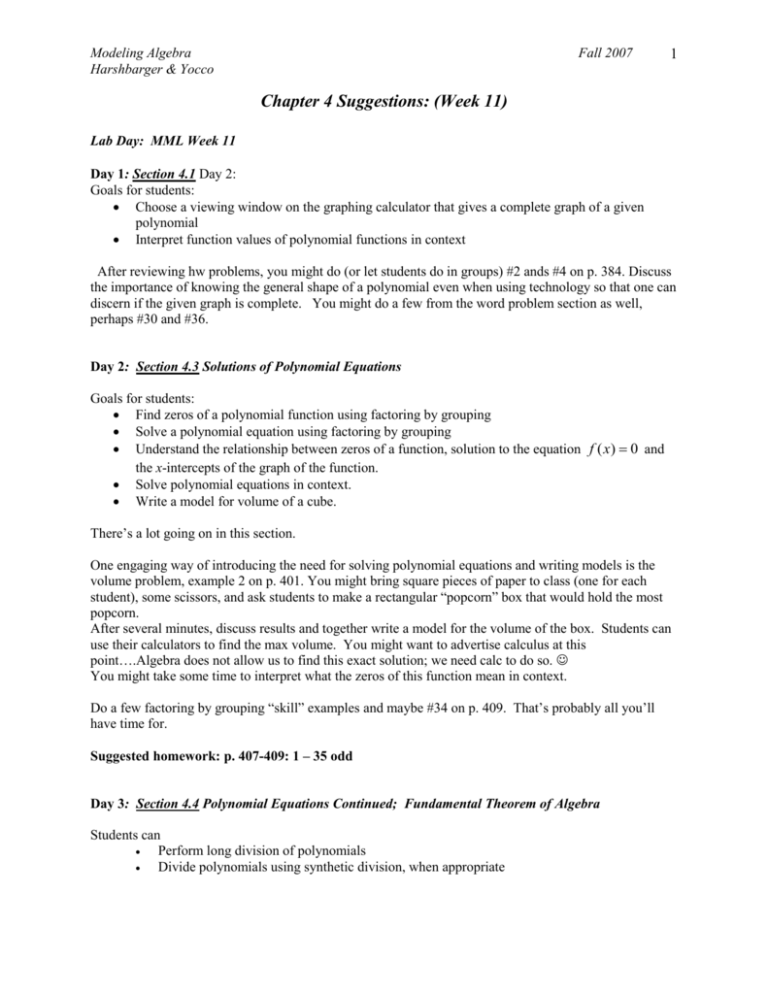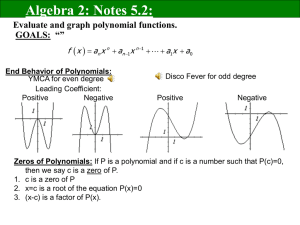Suggestions for Week 11
advertisement

Modeling Algebra Harshbarger & Yocco Fall 2007 1 Chapter 4 Suggestions: (Week 11) Lab Day: MML Week 11 Day 1: Section 4.1 Day 2: Goals for students: Choose a viewing window on the graphing calculator that gives a complete graph of a given polynomial Interpret function values of polynomial functions in context After reviewing hw problems, you might do (or let students do in groups) #2 ands #4 on p. 384. Discuss the importance of knowing the general shape of a polynomial even when using technology so that one can discern if the given graph is complete. You might do a few from the word problem section as well, perhaps #30 and #36. Day 2: Section 4.3 Solutions of Polynomial Equations Goals for students: Find zeros of a polynomial function using factoring by grouping Solve a polynomial equation using factoring by grouping Understand the relationship between zeros of a function, solution to the equation f ( x) 0 and the x-intercepts of the graph of the function. Solve polynomial equations in context. Write a model for volume of a cube. There’s a lot going on in this section. One engaging way of introducing the need for solving polynomial equations and writing models is the volume problem, example 2 on p. 401. You might bring square pieces of paper to class (one for each student), some scissors, and ask students to make a rectangular “popcorn” box that would hold the most popcorn. After several minutes, discuss results and together write a model for the volume of the box. Students can use their calculators to find the max volume. You might want to advertise calculus at this point….Algebra does not allow us to find this exact solution; we need calc to do so. You might take some time to interpret what the zeros of this function mean in context. Do a few factoring by grouping “skill” examples and maybe #34 on p. 409. That’s probably all you’ll have time for. Suggested homework: p. 407-409: 1 – 35 odd Day 3: Section 4.4 Polynomial Equations Continued; Fundamental Theorem of Algebra Students can Perform long division of polynomials Divide polynomials using synthetic division, when appropriate Modeling Algebra Harshbarger & Yocco Fall 2007 Determine whether a given constant is a solution to a given polynomial equation using synthetic division. Given one solution to a polynomial equation, find the others using synthetic division Solve polynomial equations in context using synthetic division and factoring. The focus today is on the skills of long division and synthetic division. Be sure students understand that when the remainder is zero, the divisor is a factor of the polynomial and vice versa. There is an extra worksheet with more practice problems available on the Instructor site and on the student VISTA site (“polynomial division practice”). Suggested homework: p. 418: 1-16 all and odds on the “polynomial division” worksheet Day 4: Section 4.4 Day 2: Goals for students: Given a polynomial, name the possible rational zeros Given a polynomial, find all the real zeroes using the rational zero test, synthetic division, and factoring. You might consider using this approach to the rational zero test, stressing reasoning, rather then memorization: You might begin be recalling the process of factoring a quadratic such as f ( x) x2 x 6 . How do you find the factors? In the factored form ( x a)( x b) , what does the product ab =? Similarly for other easy quadratics such as f ( x) x2 2 x 15 , f ( x) x2 7 x 10 Then you might ask them In the polynomial f ( x) x4 5x3 27 x2 31x 10 , how many (linear) factors do you think there would be? Then I’d write ( x ?)( x ??)( x ???)( x ????) . What does the product of all the ?????????? have to be? So what are the possible rational zeros? Similar questioning, then, with a polynomial with a leading coefficient not equal to 1, such as: f ( x) 3x4 4x3 x2 6x 2 which would factor into the form: (ax ?)(bx ??)(cx ???)(dx ????) How many linear factors (at most) would there be? What does the product ?????????? have to be? What are possible values for a, b, c, d? How does this affect the zeros? How do you find a zero once you know a factor? Then state the Rational Zeros Theorem. Pull everything together then and summarize the steps for finding zeros of a polynomial: 1. Use the Rational Zeros Theorem to list possible rational zeros 2 Modeling Algebra Harshbarger & Yocco Fall 2007 2. Use your graphing calculator to help narrow down the choices 3. Use synthetic division to find the zeros and list factored formula You might do an application problem, time permitting. Suggested homework: p. 418: 17- 25, 27, 32, 35, 36 and perhaps a few from the “Finding zeros and RZT” worksheet available online. 3









